Fighting to Help Others Walk Again
Marissa Koscielski ’17, ’18M.S., was in eighth grade when she fractured her pelvis and lower back in a gymnastics accident. Instead of slowly healing, she developed flu symptoms, bruising, numbness and then grueling pain. She endured numerous infections, and then an allergic reaction caused a platelet dysfunction. Her skin began to break down and her hair began to fall out. By May 2012, she was paralyzed on her left side from the waist down and was losing neurologic function on her right side.
Her mom, Maureen McNulty ’18MNA, suspected a bug bite might be the culprit of the mysterious illnesses. As she watched her daughter’s condition worsen without explanation, McNulty decided to take Koscielski to the Mayo Clinic.
“It was like her body was shutting down,” McNulty recalls. “She was so sick I was concerned how long she was going to live.”
Doctors couldn’t pinpoint the cause, and they decided to do an exploratory surgery to clean out what the surgeons hypothesized to be a residual infection. While in surgery, doctors discovered a mass that was previously interpreted as inflammation on MRIs. After they removed it, Koscielski’s health immediately stabilized, but her neurological function was not restored. Tests revealed the nerve function might never return and Koscielski would likely not walk again.
“I knew one thing to be true beyond everything: When I was in my wheelchair, my body was still degrading. My muscles were atrophying in front of my eyes and I was experiencing more complications,” Koscielski recalls, but she was undeterred. She thought to herself, “I know I get worse when I’m sitting in my wheelchair. Let’s take away my wheelchair.”
The goal was lofty. She was dedicated to her intensive physical therapy at the Mayo Clinic but there she had access to technologies like treadmill training systems and exoskeletons. Koscielski understood she needed to reestablish her independence and her rehabilitation must extend beyond her formal training sessions. Without her wheelchair and with no other available technology, she decided to MacGyver her own walker.
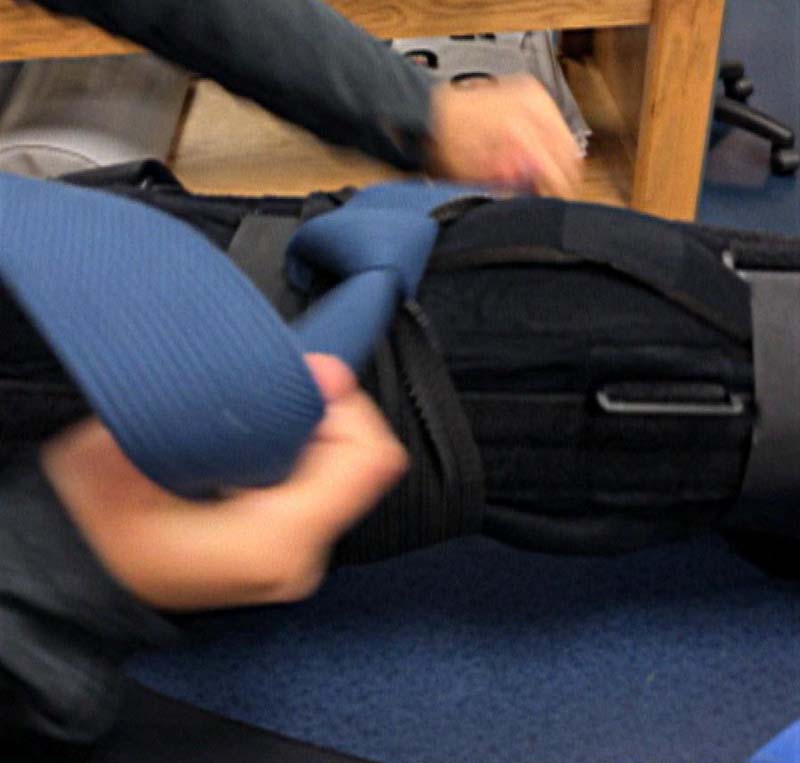 Without her wheelchair and with no other available technology, Koscielski decided to MacGyver her own walker.
Without her wheelchair and with no other available technology, Koscielski decided to MacGyver her own walker.
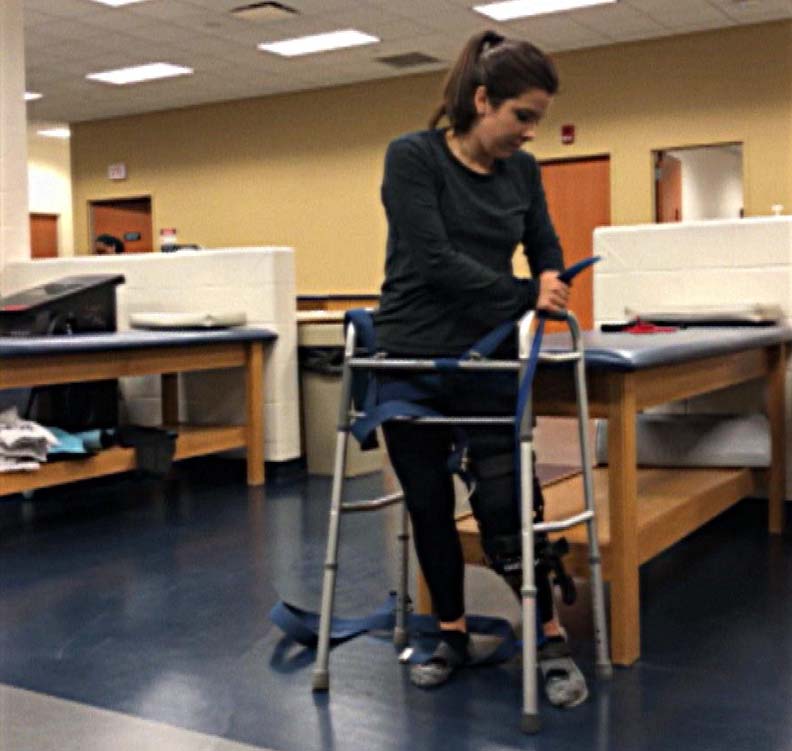 With an average walker as her base, Koscielski tried attaching gait belts, knee braces, TheraBands and other equipment to concoct something that allowed her to train independently outside her physical therapy sessions.
With an average walker as her base, Koscielski tried attaching gait belts, knee braces, TheraBands and other equipment to concoct something that allowed her to train independently outside her physical therapy sessions.
“I needed something that I could use independently so I could get up and use the restroom by myself, so I could train in the hallway eight hours a day by myself,” she says. “I needed something that empowered me to be able to be the master of my own rehabilitation.”
With an average walker as her base, Koscielski tried attaching gait belts, knee braces, TheraBands and other equipment to concoct something that allowed her to train independently outside her physical therapy sessions.
“The moments when I was trying to build a contraption and trying to figure how I was going to do this were not pretty,” she says. Many attempts ended with her on the ground or injured. “Those were very overwhelming moments, but eventually out of the failure, I fabricated something that I could use.”
 Nine weeks and hours of practice later, her muscles began to respond to take her first shaky but independent steps, sans walker.
Nine weeks and hours of practice later, her muscles began to respond to take her first shaky but independent steps, sans walker.
With her new walker to steady her, she set a goal to walk to her therapy appointment less than a quarter mile away. It took three and a half hours to traverse the block between the Ronald McDonald House and the clinic, but she succeeded. Nine weeks and hours of practice later, her muscles began to respond to take her first shaky but independent steps, sans walker. Her progress had far surpassed all expectations.
“When my team up at the Mayo Clinic saw what I had designed, they were encouraged and said this could be used for other individuals with unilateral immobility — so lower-limb amputees, stroke patients or individuals that had a neurodeficit similar to mine. That had remained in the back of my mind as I entered Notre Dame,” she says.
Koscielski became a mathematics major and sailed through her undergraduate courses in just three years, but a burgeoning desire to combine her medical experience with her academic training led her to Notre Dame’s ESTEEM program — a one-year Master of Science degree that focuses on entrepreneurship and commercialization. ESTEEM, she believed, could provide the business acumen to bridge the gap between science and business, help her commercialize a device similar to the one that helped guide her first steps and ultimately support patients like herself.
ESTEEM is housed in the IDEA (Innovation, De-Risking and Enterprise Acceleration) Center — Notre Dame’s hub for commercialization. Thanks to an entrepreneurship-centric curriculum and hands-on business experience, graduates of ESTEEM are prepared to launch new businesses or to take on leadership roles in existing corporations.
The program also requires a year-long capstone project to develop a commercialization plan for a product or existing research. Koscielski proposed to work on a plan to fill the technology void for unilateral mobility. She created a rehabilitation technology start-up, Enlighten Mobility, and planned for her first product to be a modified version of her walker. Her initial pitch wowed advisers like professor Matthew Leevy, an ESTEEM adviser and the director of the Innovation Lab at the IDEA Center.
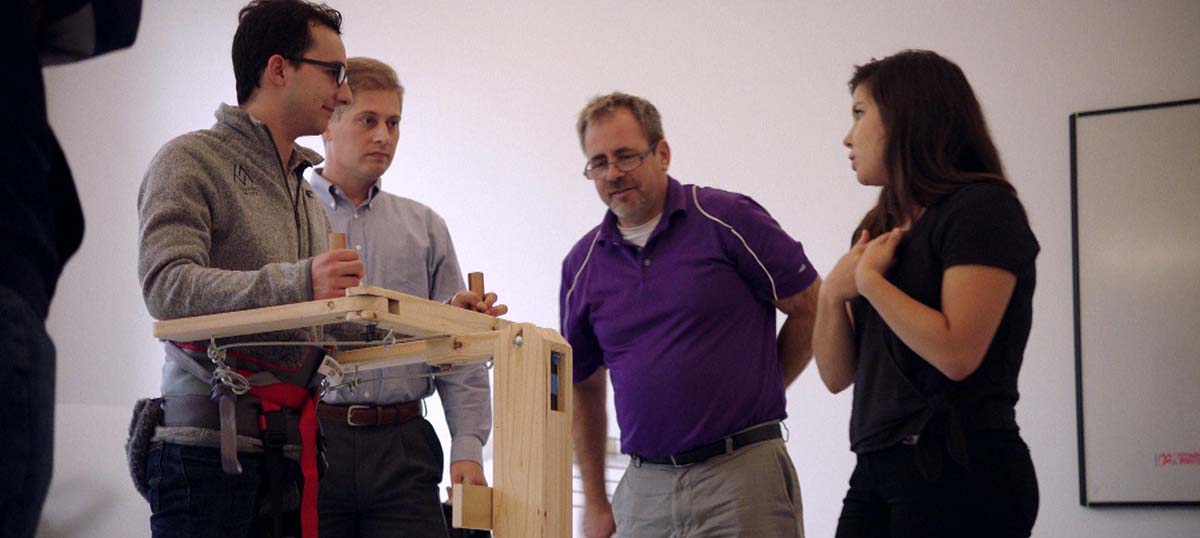 Koscielski created a rehabilitation technology start-up, Enlighten Mobility, and planned for her first product to be a modified version of her walker.
Koscielski created a rehabilitation technology start-up, Enlighten Mobility, and planned for her first product to be a modified version of her walker.
“I think we all immediately knew there was something there that we wanted to explore,” Leevy says. “The mission of ESTEEM is to fix things that matter. In a sense, ESTEEM provides this platform on which students can do these entrepreneurial pursuits. … They are meant to have a social component really benefiting humanity and that certainly fits this.”
Koscielski understood firsthand the technology void in the rehabilitation market, but she wanted to better understand the limitations of other types of unilateral immobility patients — like amputees and stroke survivors — so she could adapt her walker to serve them.
“I wanted to go in the trenches and accompany these individuals throughout their journey to learn about their hardships and celebrate in their triumphs. It was a remarkable experience and sometimes I can relate to the pains, frustrations and fear all too well,” she says.
“Perhaps my experience has allowed me to connect with these individuals on a deeper level than individuals who haven’t been in those trenches before. Hearing patients’ stories, learning alongside them and seeing their growth over time has enabled us to engineer technology that is specially designed for these populations.”
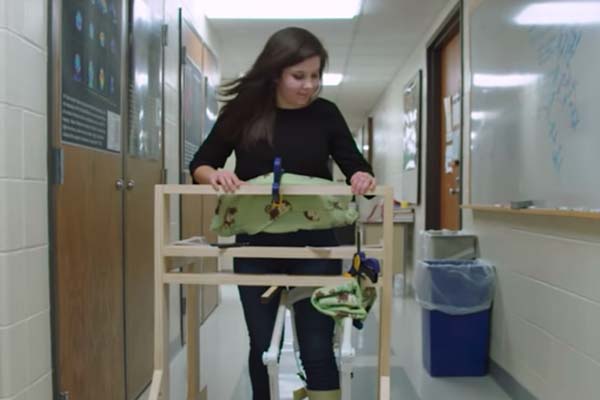
The establishment of the IDEA Center has led to an explosion of student entrepreneurial activities on campus, and Marissa stands as one of many exciting examples.
Each year there are more than 180,000 lower-limb amputations. Koscielski explains that most of these individuals go home within days of their life-altering surgery, but then wait months or even years before being fitted for a prosthetic or starting therapy. The problem, she says, is that during that waiting period there can be irreversible damage from deterioration. So Koscielski helped design the Enlight Gait Trainer so amputees can start rehabilitating immediately after surgery. “Oftentimes individuals fall through the cracks of our medical system and are restricted to their home, invisible to our society. We believe through our technology, we can help restore their resilience, take steps forward and grow together to make them possible. It is a really rewarding and humbling process.”
“We have designed specialized gait trainers that allow these individuals to walk as if they hadn’t had surgery at all or if they already were ambulating in their prosthetic. This device is engineered to faithfully replicate healthy human walking motion. Therefore, by the time the individual receives her prosthetic, she is ready to hit the road running,” she says.
With help from ESTEEM advisers, Notre Dame faculty and the IDEA Center, along with members of the Enlighten Mobility Team — Jeff Riney ’19, Rory Burke ’18, Jacob Burger ’14, ’19MBA, Adrian Rodriguez ’18, Sean Bolton ’18 and Leanne Tang ’20 — Koscielski finished her capstone in time to enter it into the McCloskey New Venture Competition in April 2018, where she split the $50,000 Grand Prize with startup SecurSpace. She was also awarded $5,000 as the winner of the Sutherland Family Award for Best Presentation.
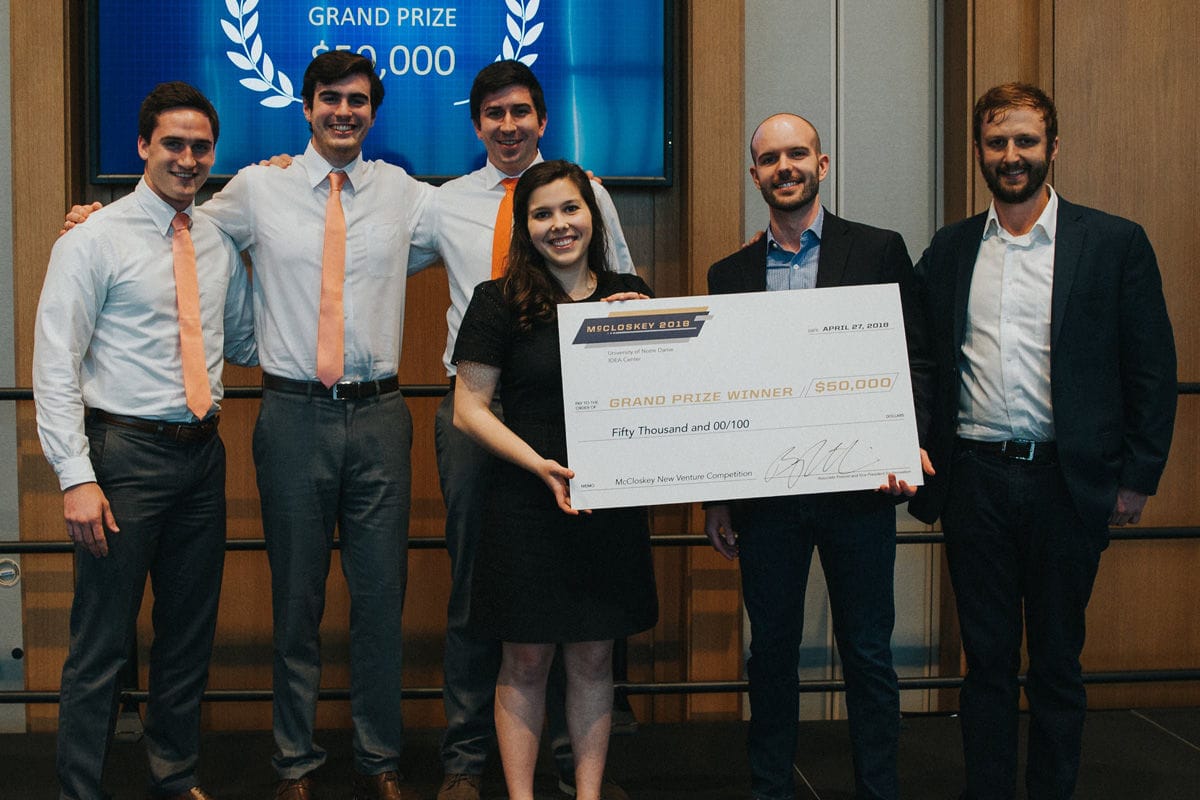 From left to right are Jeff Riney ’19, Rory Burke ’18, Jacob Burger ’14, ’19MBA and Koscielski ’17, ’18M.S of Enlighten Mobility. The team split the $50,000 McCloskey Grand Prize with SecurSpace.
From left to right are Jeff Riney ’19, Rory Burke ’18, Jacob Burger ’14, ’19MBA and Koscielski ’17, ’18M.S of Enlighten Mobility. The team split the $50,000 McCloskey Grand Prize with SecurSpace.
“The success wasn’t surprising,” says Leevy, noting Koscielski’s tenacity and how she expertly leveraged campus resources to pursue a project she was genuinely passionate about. The result, he says, is the perfect embodiment of ESTEEM’s goals.
“To have [Enlighten Mobility] emerge as this powerful startup with the ability to affect so many lives in such a positive way is what is incredibly special for Marissa, for Notre Dame, for the ESTEEM Program, for the IDEA Center, for the Notre Dame network. Everybody can be proud of this,” he says.
Since the competition, Koscielski has graduated from ESTEEM and Enlighten Mobility continues to make strides to provide health trajectories not otherwise possible. The Enlight Gait Trainer is on track to be on the market within a year, and the team is also developing neuromodulation for coordinated movements for individuals with neurodeficits, biofeedback augmented reality for gait training, endurance treadmill training and diagnostic and therapeutic equipment for muscular dystrophy.
“I came to Notre Dame because of its mission — that our education here becomes service to justice. Enlighten Mobility is my way of my education becoming service to justice,” she says. “Notre Dame has provided our team the perfect ecosystem to make that happen.”
